2
3
Technical Vision of Slicing Packet Network (SPN) for 5G TransportTechnical Vision of Slicing Packet Network (SPN) for 5G Transport�
Contents
1 Requirements and Vision ............................................................................. 1
1.1 Driving Force ................................................................................................ 2
1.1.1 Wireless Services ...................................................................................2
1.1.2 Residential Services................................................................................3
1.1.3 Enterprise Services .................................................................................4
1.1.4 DCI Services ............................................................................................4
1.2 Key Requirements for new Transport Networks .......................................... 5
1.3 SPN Vision .................................................................................................... 6
2 Principles and Architecture .......................................................................... 7
2.1 SPN Design Principles ................................................................................... 8
2.2 Technical Architecture .................................................................................. 9
3 Key Technologies ........................................................................................ 13
3.1 Slicing Ethernet .......................................................................................... 14
3.1.1 Slicing Ethernet Requirements ............................................................14
3.1.2 Slicing Ethernet Technology .................................................................15
3.2 Efficient High-Bandwidth Technology ......................................................... 17
3.2.1 Efficient High-Bandwidth Requirements .............................................17
3.2.2 Efficient High-Bandwidth Technology ..................................................17
3.3 Deterministic Low Latency Technology ...................................................... 19
3.3.1 Slicing Packet Deterministic Low Latency Technology........................19
3.3.2 Slicing Ethernet Deterministic Low Latency Technology .....................20
4
5
Technical Vision of Slicing Packet Network (SPN) for 5G TransportTechnical Vision of Slicing Packet Network (SPN) for 5G Transport�
3.4 Flexible and Reliable Connection Technology ............................................ 22
3.4.1 Flexible Connection Requirements ......................................................22
3.4.2 Flexible Connection Technology ..........................................................22
3.5 Ultra-High Precision Synchronization Technology ...................................... 23
3.5.1 High-Precision Time Synchronization Requirements ..........................23
3.5.2 SPN Time Synchronization Network Model .........................................24
3.5.3 Ultra-High Precision Synchronization Technology for the SPN ...........25
3.6 Centralized Management and Control Technology of SDN ........................ 27
3.6.1 Requirements .......................................................................................27
3.6.2 Key Technologies for Intelligent Operations .......................................28
3.6.3 Architecture of the Intelligent Operating System................................30
4 Application Scenarios ................................................................................. 33
4.1 Mobile Service Transport .......................................................................... 34
4.1.1 Fronthaul Network ..............................................................................34
4.1.2 Midhaul/Backhaul Network ................................................................35
4.2 Data Center Interconnection ...................................................................... 35
4.2.1 Multi-point Interconnection Between Edge DCs over the SPN ..........36
4.2.2 Point-to-Point Interconnection Between DCs over the SPN ..............36
4.3 Video Everywhere ...................................................................................... 37
4.4 Cloud Private Line....................................................................................... 38
4.4.1 Cloud Connection ................................................................................38
4.4.2 Cloud Application ................................................................................39
5 Summary and Prospect .............................................................................. 41
1
Requirements and Vision
6
1
Technical Vision of Slicing Packet Network (SPN) for 5G TransportTechnical Vision of Slicing Packet Network (SPN) for 5G Transport�
As 4G has profoundly changed people’s life, 5G will further bring fundamental
changes to the society. It is expected that a fully mobile and connected world will
be performed. In particular, networks are and will always be the cornerstone with
the rapid development of the information era. The 5G transport network should
be a part of a converged multi-service network that supports wireless services, res-
idential services, enterprise services, and Data Center Interconnect (DCI) services.
1.1 Driving Force
1.1.1 Wireless Services
3GPP has defined three typical scenarios of 5G, namely eMBB (enhanced Mobile
Broadband), URLLC (Ultra-high Reliability, Low Latency Communication) and mMTC
(massive Machine Type of Communication). These new applications will bring
great challenges to the transport network as follows:
Traffic rate will grow 1000 times
It is estimated that the total global mobile data traffic will be up to 1000 times
from 2010 to 2020. The corresponding throughput will reach 100 Gbit/s per square
kilometer, which is also required to grow 1000 times.
Number of connections will increase 100 times
With the rapid development of the Internet of Things (IoT), the total number
of devices connected by the mobile network will be between 50 and 100 billion
by 2020. Thus, the connection density will also be increased significantly. In sever-
al cases, the connection density of 5G mobile networks will reach 1 million/km2,
which is 100 times larger than that of 4G networks.
10 Gbit/s peak data rate
Nowdays, the peak data rate of 4G networks is around 1 Gbit/s. In the 5G era,
this rate will be improved to 10 Gbit/s to meet the user requirements.
10 Mbit/s user experienced data rate
In 2020, the user experienced data rate will be larger than 10 Mbit/s in the
vast majority of cases. Furthermore, the 5G network could provides 100 Mbit/s
data rate for several high-priority services, such as HD medical image transmission
in emergency vehicles.
Lower latency and higher reliability
Compared with 4G, 5G should have 5 to 10 times of decrease in the latency
from the terminal device to the core network. Moreover, for the services relat-
ed to human life and property security, the E2E reliability should be increased to
99.999%.
Improved spectral efficiency
According to ITU, the minimum value of the mean spectral efficiency in out-
door for IMT-A should be 2 bps/Hz to 3 bps/Hz. To resolve the shortage of spectral
resources caused by explosive growth on traffic, the mean spectral efficiency of 5G
should be 5 to 10 times higher than that of 4G.
Figure 1-1: 5G system requiring new transport networks
1.1.2 Residential Services
With the rapid development of new services, such as 4K/8K video, virtual reality
(VR)/augmented reality (AR), IoT, Big Data, Industry 4.0, and artificial intelligence
(AI), etc., existing residential broadband is faced with enormous challenges. As
people’s desire for better experience is never-ending, it will further drive up the
quality of residential broadband. However, there is still an obvious performance
2
3
Technical Vision of Slicing Packet Network (SPN) for 5G TransportTechnical Vision of Slicing Packet Network (SPN) for 5G Transport�
difference between the user-experienced bandwidth and the subscribed band-
width, especially in a Wi-Fi network. To pursuit better experience, video service
will have more strict requirements on transmission rate and latency. In addition,
carriers have spent so much time on service provisioning and failure processing,
resulting in degradation of user experience. Cloud-based strategies could be intro-
duced to improve the management efficiency.
1.1.3 Enterprise Services
For government and enterprise customers, carriers provide broadband access and
lease line services among different nodes. The rapid development of the IT indus-
try will exhaust the bandwidth of the existing enterprise private lines in the near
future and promote continuous demand on high-speed private lines. For different
scenarios, there are three main types of private lines: IDC interconnection private
line, high-value government and enterprise private line, and small and medium
enterprise private line. Cloud services are benefit to enhance the management
capability of private lines. Meanwhile, the clouded MEC will be further allocated
toward the edge of the network which will bring tremendous challenges to the
transport network. Simple bandwidth leasing cannot satisfy the requirements of
large enterprises. Compared with the traditional private line service, virtual net-
work leasing may be a promising way in the future.
1.1.4 DCI Services
The DC-based network architecture will change the traditional traffic model of the
transport network. The transport network should support more flexible flows and
diversified reliability. It is noted that the SDN technology is the key part of DCI ser-
vices. The controller should achieve the WAN level interconnection between DCs
and the orchestrator should realize resource scheduling across DCs. The SDN tech-
nology also supports forwarding and control of element separation and centralized
routing computation.
1.2 Key Requirements for New Transport Networks
The advent of the digital society will exert profound influence on the communica-
tions infrastructure network, and the traffic model of the existing communications
network will change dramatically. The connection density and traffic density will
increase at an unprecedented rate and the geographical network coverage will be
greatly extended. Users of different types pose personalized requirements on net-
works, and the requirements for real-time interaction of specific industries are ex-
tremely high. Therefore, the next-generation transport network architecture must
meet the following requirements:
High bandwidth: The transport network needs to provide low-cost and
high-bandwidth capabilities. The throughput capability should be larger than 1
Gbit/s per user, and the network should support the continuous development of
video, holographic, and VR applications.
Low latency: It should support an E2E latency better than 1 ms to meet the
stringent requirements of interactive experience and industrial control.
Flexible connection: The total number of connections has increased by sever-
al dozen times, and the new network should satisfy Full-Mesh data connection in
the huge network with more than 10,000 nodes.
Network openness: It should support standardized southbound interface and
northbound interface. In this manner they have the potential of leveraging the ver-
satility and openness of the SDN control plane for implementation of the service
control they are generating in either a virtual or a physical deployment or both.
Network slicing: Diversified services bring about diversified network require-
ments. In the future, the transport network should be equipped with dynamic
network slicing capabilities to meet diversified service requirements. The network
should provide the capability of both hard isolation and soft isolation.
High reliability: It should provide ultra-high reliability connections for new
services such as AR, industrial control, and telemedicine.
Intelligent O&M: The service model changes fundamentally. Network slicing
and Full Mesh traffic require a more intelligent network O&M system to reduce
the OPEX.
4
5
Technical Vision of Slicing Packet Network (SPN) for 5G TransportTechnical Vision of Slicing Packet Network (SPN) for 5G Transport�
1.3 SPN Vision
Slicing packet network (SPN) focuses on building an efficient, simplified, and ul-
tra-broadband transport network to support the deferent services on the metro
network.
New architecture: The new technology architecture provides a low-cost and
simplified transport network. The bandwidth of the network is 100 times higher,
and the cost per a single bit is 10 to 100 times less.
New services: SPN focuses on the support for new services on the transport
network. The latency is 10 to 100 times less, and the number of service connec-
tions is 100 times greater.
New operations: The brand new O&M platform provides agile service deploy-
ment and operation capabilities. The OPEX is 10 times lower.
The SPN is positioned as a next-generation converged transport network
based on the Ethernet ecosystem to implement comprehensive service transport
with high bandwidth, low latency, and high efficiency.
The SPN carries the following services: wireless services, enterprise services,
residential services, and cloud interconnection services.
2
Principles and Architecture
6
7
Technical Vision of Slicing Packet Network (SPN) for 5G TransportTechnical Vision of Slicing Packet Network (SPN) for 5G Transport�
2.1 SPN Design Principles
The SPN takes advantage of efficient Ethernet ecosystem to provide low-cost and
high-bandwidth transport network services. With the efficient convergence of
multi-layer network technologies, flexible soft isolation slicing and hard pipe slicing
are implemented, and multi-layer service transport capabilities from L0 to L3 are
all provided. SDN centralizes management and control to innovatively implement
open, agile, and efficient network operations. SPN principles are as follows:
Packet friendly: Drawing on Ethernet technology (IEEE 802.3 Ethernet,
OIF FlexE, and innovative slicing Ethernet), the SPN shares the IP/Ethernet
ecosystem (optical modules, protocols and chipsets), and support main-
stream packet clients friendly.
Multi-layer network technology convergence: With the efficient conver-
gence of IP, Ethernet, and optical technologies, hierarchical networking at
L0 through L3 can be implemented to allow for the construction of various
types of pipes. Ethernet packet scheduling is used for flexible connections
of packet services. Innovative slicing Ethernet data unit stream scheduling
is used to support hard pipe isolation and bandwidth guarantee for ser-
vices and provide low-latency service transport network channels. Opti-
cal-layer wavelength grooming is used to support smooth capacity expan-
sion and large-granularity service grooming.
Highly efficient soft and hard slicing: Both highly reliable hard slicing and
elastic scalable soft slicing capabilities are provided. Such capabilities iso-
late resources of a physical network to run multiple virtual networks and
provide differentiated SLA-based transport network services for multiple
types of services.
SDN centralized management and control: SDN helps implement open,
agile, and efficient network operations and maintenance. Service provi-
sioning and O&M are automated. SPN can monitor network status and
trigger network self-optimization in real time. In addition, the architecture
with converged SDN-based management and control provides the other
capabilities, such as simplified network protocols and open networks, as
well as cross-network domain and cross-technology service coordination.
Carrier-grade reliability: Network-level hierarchical OAM and protection
capabilities are supported. OAM is used to monitor logical layers, network
connections, and services on the network, which implements all-round
network reliability and supports high-reliability service transport.
High-precision synchronization: In-band clock and time synchroniza-
tion-based transmission is implemented, with high reliability, high preci-
sion, and high efficiency.
Flexible service scheduling: The SPN uses flexible tunneling, addressing,
and forwarding techniques to flexibly schedule P2P, P2MP, and MP2MP
services. Slicing Ethernet addressing and forwarding are used to imple-
ment Layer 1 service scheduling. MAC and MPLS addressing and forward-
ing are used to implement Layer 2 service scheduling. IP addressing and
forwarding are used to implement Layer 3 service scheduling
Figure 2-1: SPN network architecturee
2.2 Technical Architecture
Based on the ITU-T network model, the SPN uses Ethernet as the basic technology
and supports the integrated transport of IP, Ethernet, and constant bit rate (CBR)
services. The SPN technology architecture consists of the slicing packet layer (SPL),
slicing channel layer (SCL), slicing transport layer (STL), time and clock synchroniza-
8
9
Technical Vision of Slicing Packet Network (SPN) for 5G TransportTechnical Vision of Slicing Packet Network (SPN) for 5G Transport�
provide E2E Ethernet-based virtual network connections, and establish
low-latency and hard isolated slicing channels for multi-service transport
at L1. Drawing on OAM and protection functions for slicing Ethernet chan-
nels, the SCL implements E2E performance monitoring and failure recov-
ery.
STL: uses IEEE 802.3 Ethernet physical layer technology and OIF FlexE tech-
nology to implement efficient high-bandwidth transmission. The Ethernet
physical layer is composed of new high-speed Ethernet interfaces, such as
50GE, 100GE, 200GE, and 400GE. By virtue of the Ethernet industry chain,
low-cost and high-bandwidth network construction is implemented, and
mainstream networking applications with up to 80 km between hops are
supported. For applications that require higher bandwidth scalability and
longer transmission distance, the SPN uses the Ethernet+DWDM combi-
nation to implement networking of the 10T-scale capacity and hundreds
of kilometers of long distances.
tion module, and management and control function module.
Figure 2-2: Layered SPN network model
SPL: By implementing addressing, forwarding, and transport channel en-
capsulation for IP, Ethernet, and CBR services, the SPL provides various
types of services, such as Layer 2 virtual private network (L2VPN), L3VPN,
and CBR transparent transport. The SPL performs service mapping using
multiple addressing mechanisms, such as IP, Multiprotocol Label Switch-
ing (MPLS), 802.1q, and physical ports, and provides service identification,
traffic engineering, and quality of service (QoS) guarantee. For packet
services, the SPL provides the segment routing-transport profile (SR-TP)
tunnels and provides both connection-oriented and connectionless trans-
port channels. The source-route-based segment routing technique allows
the ingress to use a set of segments (MPLS labels) to identify each tun-
nel forwarding path. Unlike conventional tunneling technologies, transit
nodes do not need to maintain path status information for segment rout-
ing tunnels, which allows for flexible path adjustment and network pro-
grammability. SR-TP tunneling technology enhances O&M capabilities of
SR tunnels and supports bidirectional tunnels and E2E service-level OAM
detection.
SCL: provides E2E channelized group channels for network services and
slices. The SCL uses innovative slicing Ethernet (SE) to implement timeslot
processing on Ethernet physical interfaces and FlexE bonding groups,
10
11
Technical Vision of Slicing Packet Network (SPN) for 5G TransportTechnical Vision of Slicing Packet Network (SPN) for 5G Transport�


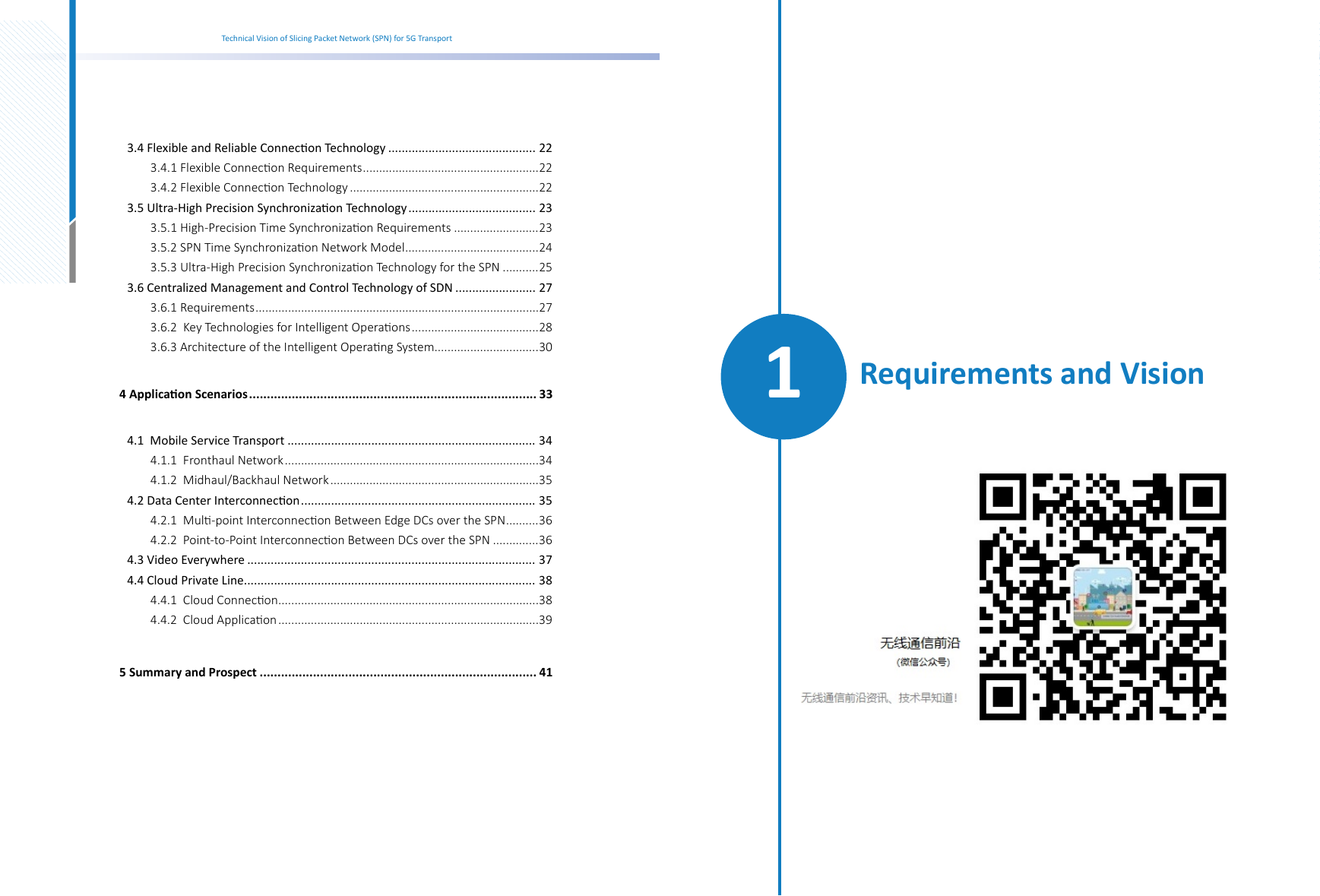
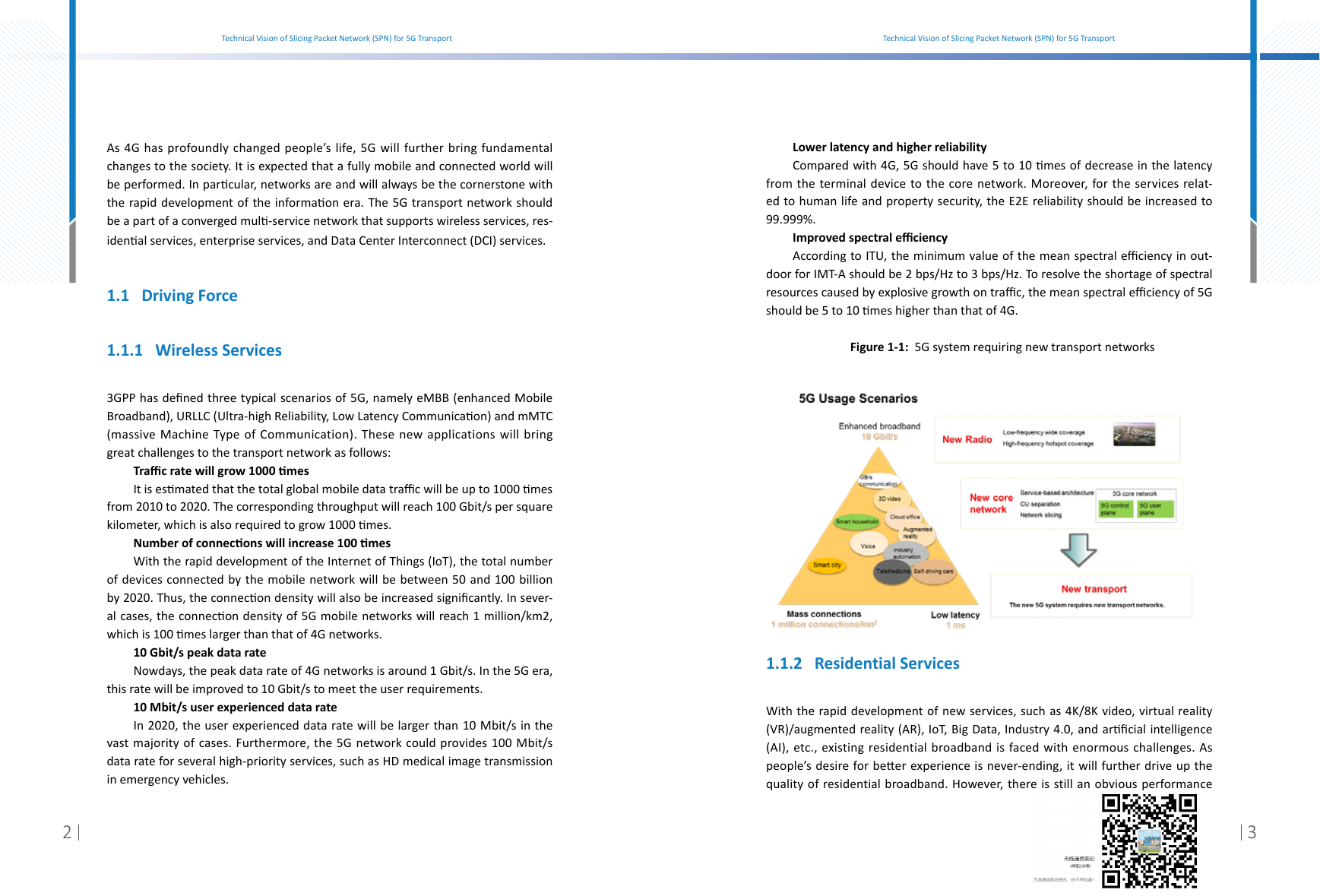
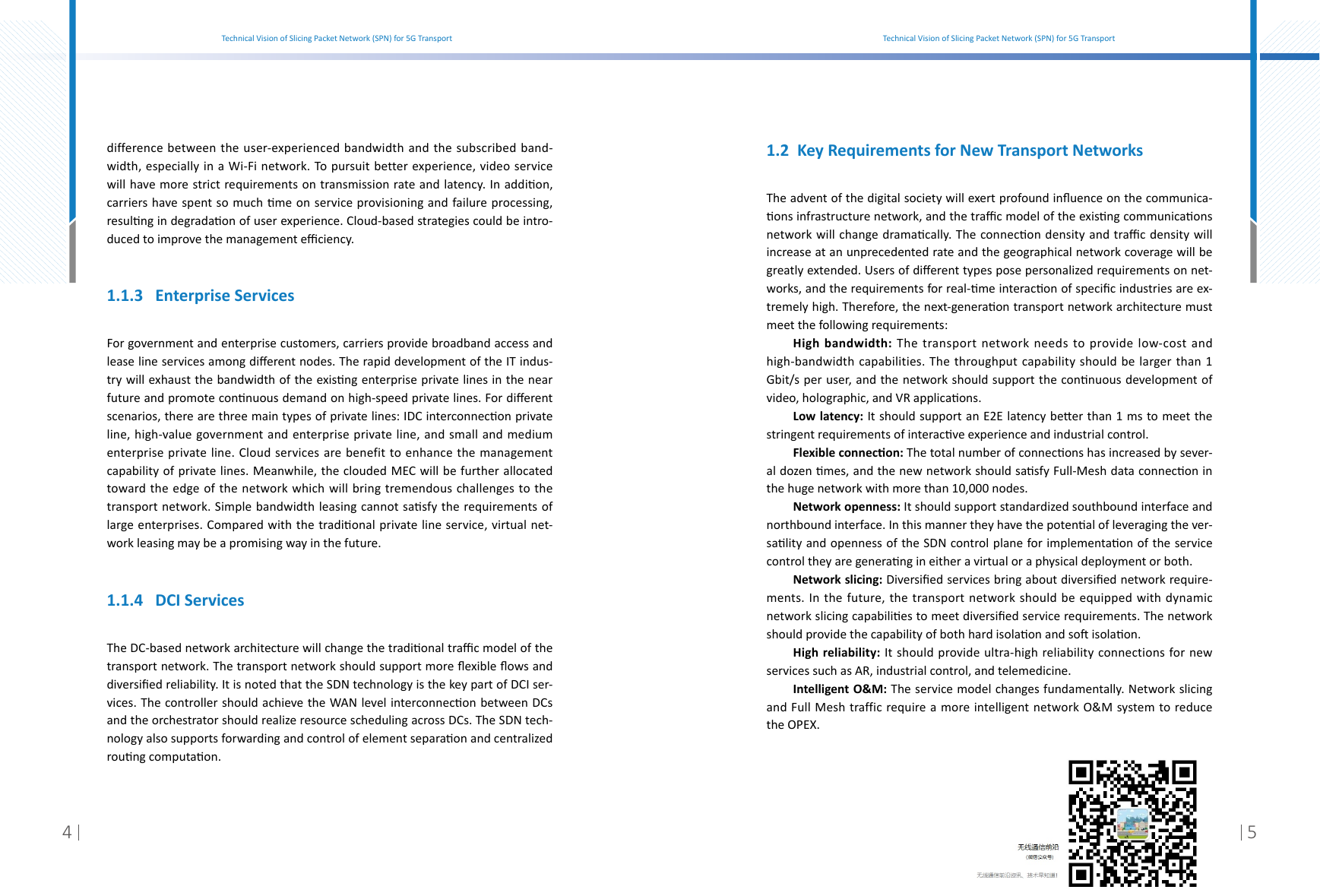
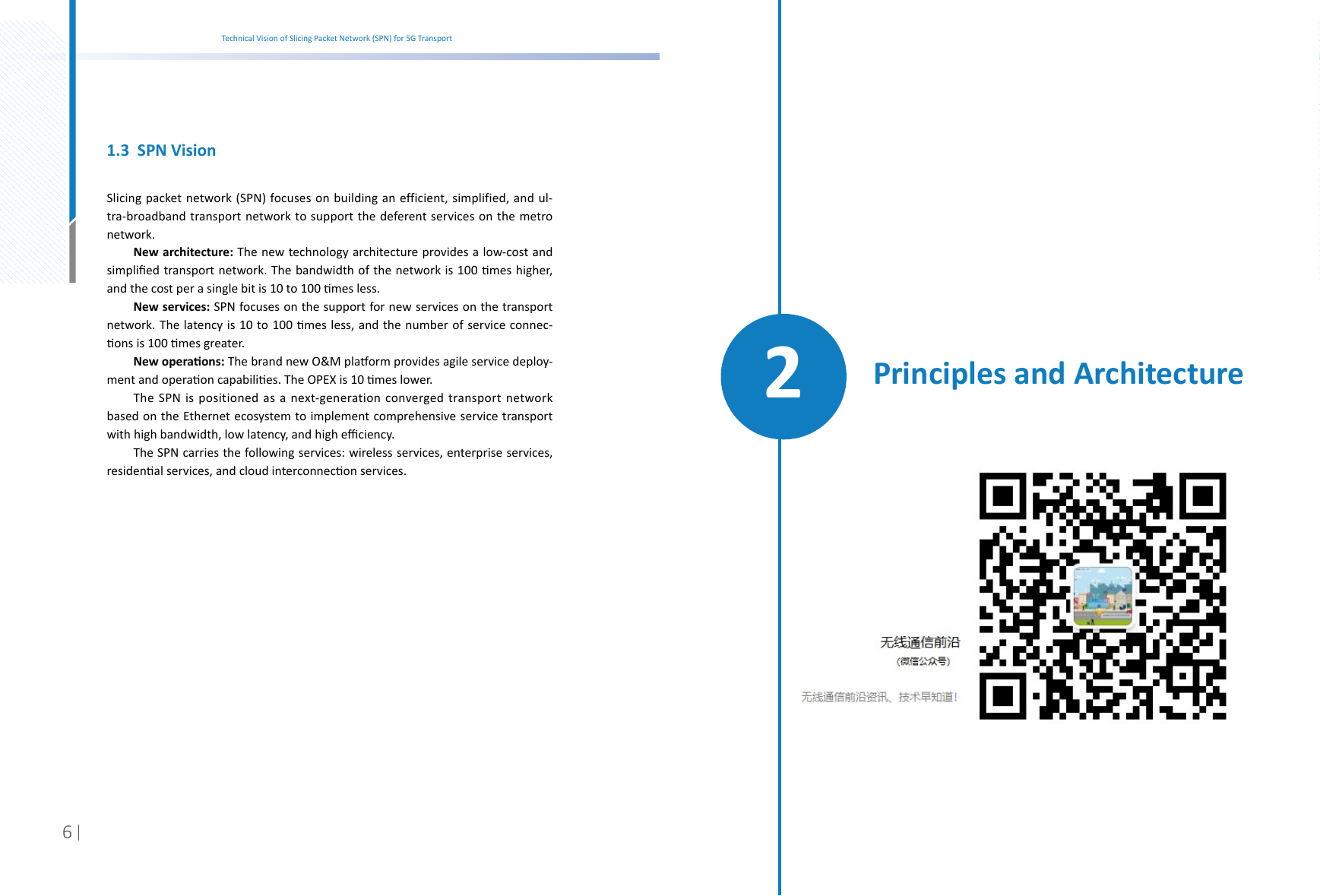
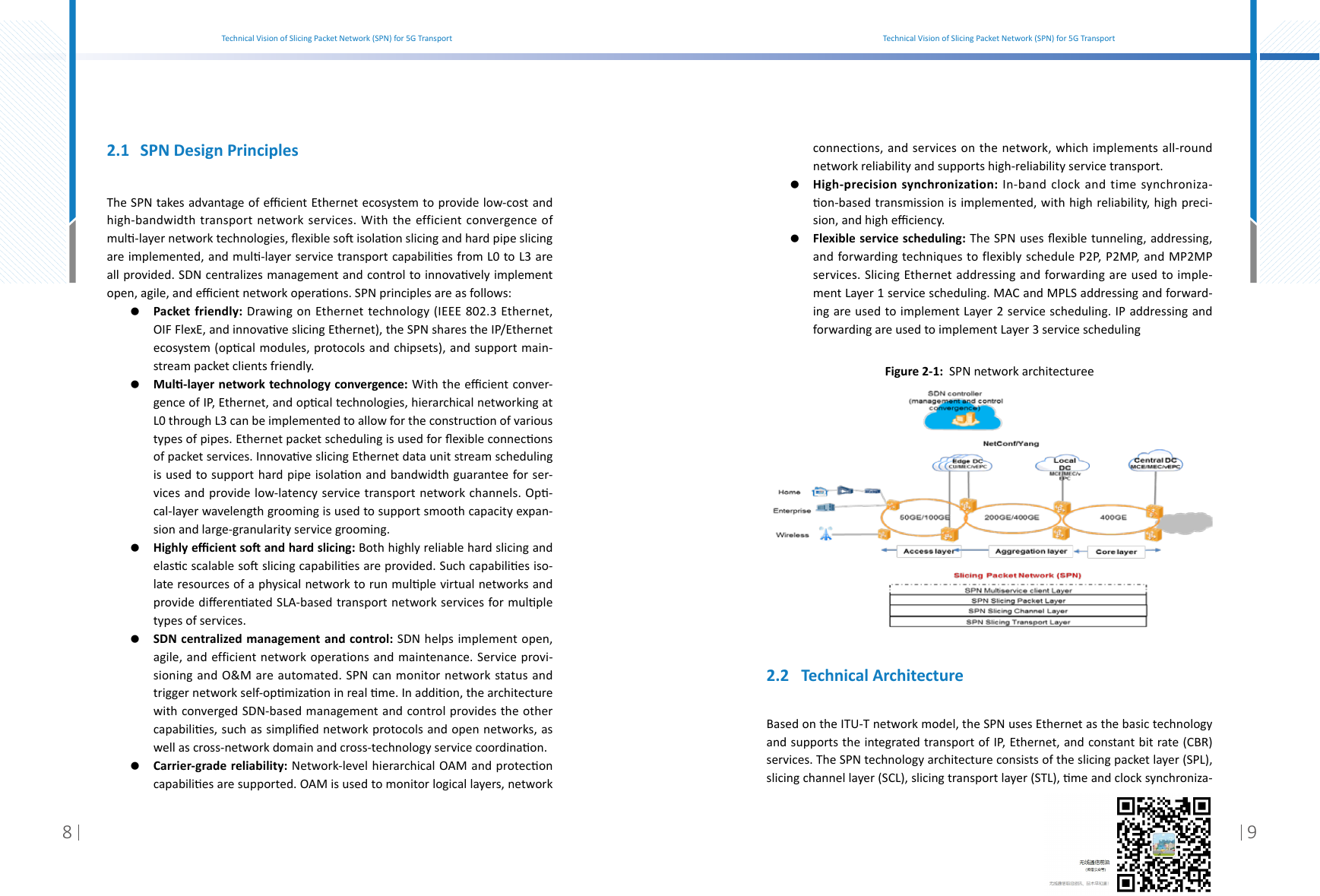
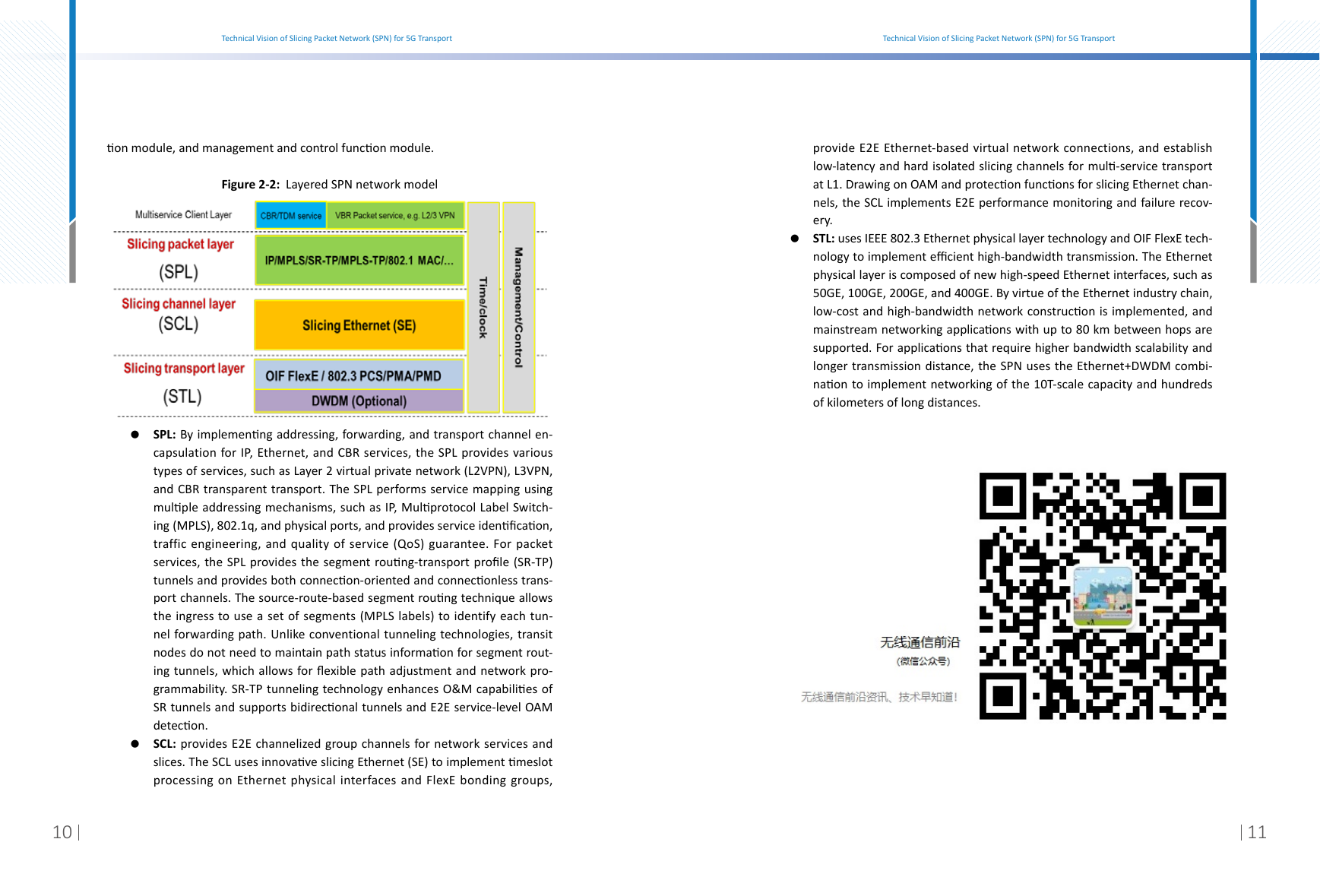








 2023年江西萍乡中考道德与法治真题及答案.doc
2023年江西萍乡中考道德与法治真题及答案.doc 2012年重庆南川中考生物真题及答案.doc
2012年重庆南川中考生物真题及答案.doc 2013年江西师范大学地理学综合及文艺理论基础考研真题.doc
2013年江西师范大学地理学综合及文艺理论基础考研真题.doc 2020年四川甘孜小升初语文真题及答案I卷.doc
2020年四川甘孜小升初语文真题及答案I卷.doc 2020年注册岩土工程师专业基础考试真题及答案.doc
2020年注册岩土工程师专业基础考试真题及答案.doc 2023-2024学年福建省厦门市九年级上学期数学月考试题及答案.doc
2023-2024学年福建省厦门市九年级上学期数学月考试题及答案.doc 2021-2022学年辽宁省沈阳市大东区九年级上学期语文期末试题及答案.doc
2021-2022学年辽宁省沈阳市大东区九年级上学期语文期末试题及答案.doc 2022-2023学年北京东城区初三第一学期物理期末试卷及答案.doc
2022-2023学年北京东城区初三第一学期物理期末试卷及答案.doc 2018上半年江西教师资格初中地理学科知识与教学能力真题及答案.doc
2018上半年江西教师资格初中地理学科知识与教学能力真题及答案.doc 2012年河北国家公务员申论考试真题及答案-省级.doc
2012年河北国家公务员申论考试真题及答案-省级.doc 2020-2021学年江苏省扬州市江都区邵樊片九年级上学期数学第一次质量检测试题及答案.doc
2020-2021学年江苏省扬州市江都区邵樊片九年级上学期数学第一次质量检测试题及答案.doc 2022下半年黑龙江教师资格证中学综合素质真题及答案.doc
2022下半年黑龙江教师资格证中学综合素质真题及答案.doc